Key takeaways:
- Urban gardening fosters a connection to nature, promotes community bonding, and enhances sustainability by reducing food transport emissions.
- Implementing urban gardens in restaurants provides fresh ingredients and educates patrons, transforming the dining experience and encouraging sustainability conversations.
- Challenges in urban gardening include limited sunlight, pest management, and watering difficulties, highlighting the need for adaptability and attentiveness.
- Success in urban gardening relies on choosing appropriate containers, understanding microclimates, and engaging with local gardening communities for shared knowledge.
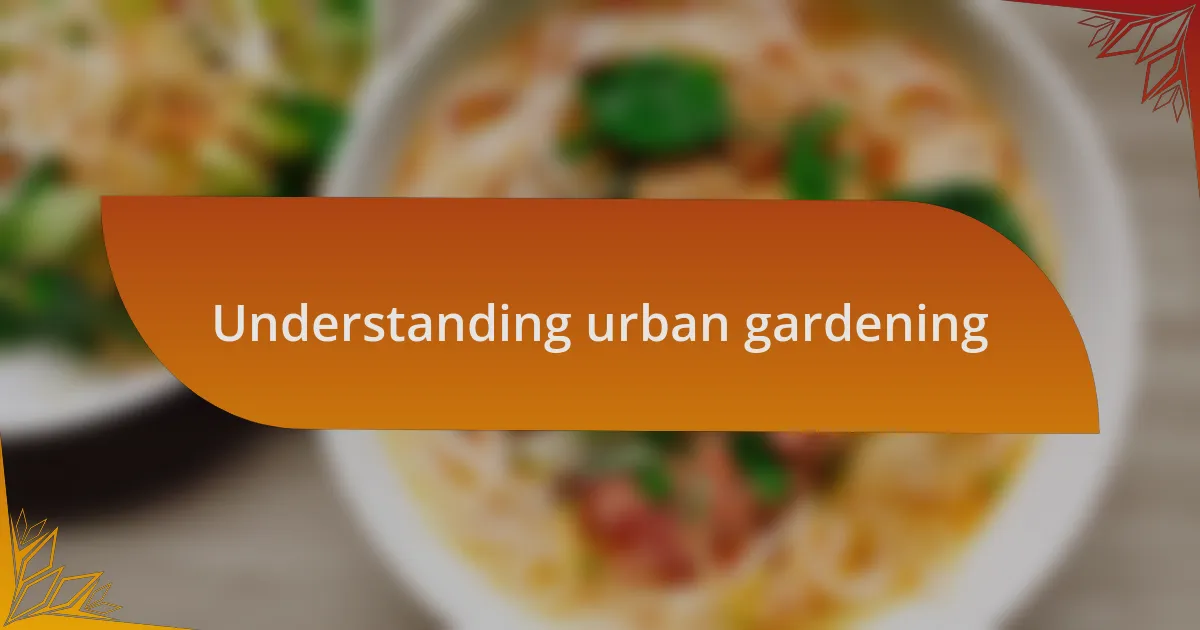
Understanding urban gardening
Urban gardening is an innovative way to utilize smaller spaces in cities, allowing anyone to grow their own food, regardless of the size of their living area. I remember my first attempt; I was convinced I couldn’t grow anything in my tiny balcony, yet I was thrilled to see my little herb garden flourish. Isn’t it amazing how green can spring up even in the most unexpected places?
The beauty of urban gardening lies in its flexibility; you can adapt it to your lifestyle and surroundings. For instance, I experimented with vertical gardening by using old pallets, turning my space into a vibrant display of greens. Each plant feels like a small victory, fostering a deep connection with nature, even in a bustling city.
As I walked through community gardens, I was struck by the sense of unity they foster among neighbors. Have you ever considered how sharing gardening tips and produce creates bonds that enrich our urban lives? It’s this communal aspect that not only helps us grow food but also builds a supportive network of like-minded individuals who care about sustainability and well-being.
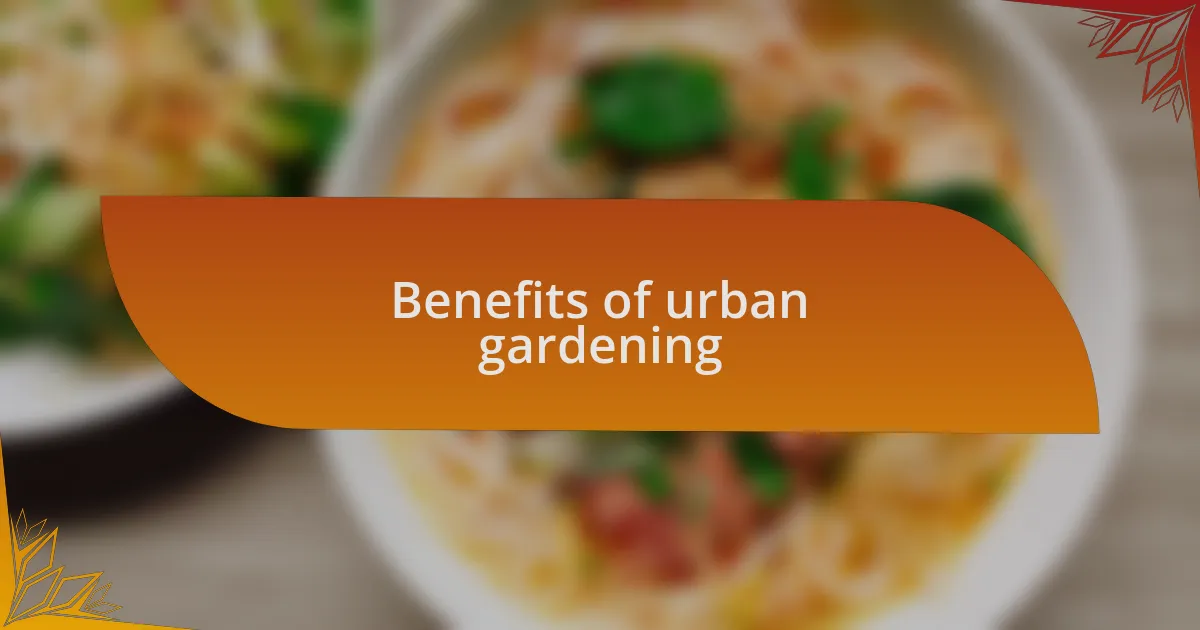
Benefits of urban gardening
One of the biggest benefits of urban gardening is the fresh produce it brings right at your fingertips. I still recall the first time I picked a tomato from my rooftop garden; it was a simple red sphere, but the burst of flavor was unlike anything I had tasted before. Can you imagine the satisfaction of serving a salad made from greens you nurtured yourself? It transforms meals into an experience.
Beyond the fresh food, urban gardening is a refuge from the city’s hustle and bustle. I often find myself escaping to my small garden space, where the plants provide a calming presence amidst the noise. Have you ever felt the stress of the day dissolve as you tend to the soil? That moment of connection with nature is not just restorative; it also cultivates mindfulness and enhances overall well-being.
Moreover, urban gardening significantly reduces the carbon footprint associated with food transport. I discovered this impact when I learned that the average meal travels over 1,500 miles before it reaches the plate. By growing my herbs and vegetables, I now play a small part in reducing that distance. Isn’t it rewarding to know that even a tiny garden can help promote sustainability in a larger context?
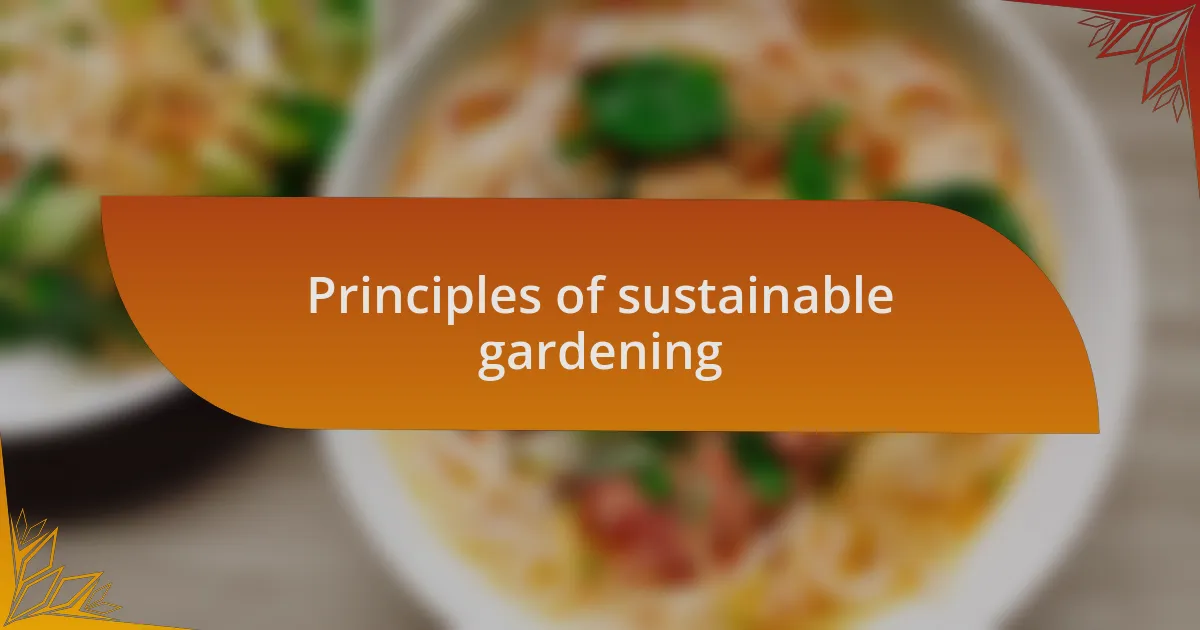
Principles of sustainable gardening
Sustainable gardening begins with understanding the harmony between nature and our gardening practices. I remember the first time I decided to plant cover crops for soil health. The experience was eye-opening; as I watched the soil enrich itself over time, I realized that working with nature rather than against it truly yields the best results. Are we really harnessing the potential of the earth if we ignore its natural cycles?
Another principle is biodiversity, which I didn’t fully appreciate until I introduced a variety of plants in my urban space. When I noticed more pollinators visiting my flowers, I felt an immense satisfaction—it’s akin to hosting a vibrant community gathering. How much more can we learn about ecosystem balance when we invite different species into our gardens, boosting both resilience and productivity?
Water conservation is also crucial. Early in my gardening journey, I often wasted water unknowingly. It was a revelation when I set up a rainwater collection system; not only did it save resources, but it also nurtured my plants with natural precipitation. Have you ever realized how small changes can lead to a more sustainable practice that benefits both your garden and the environment?
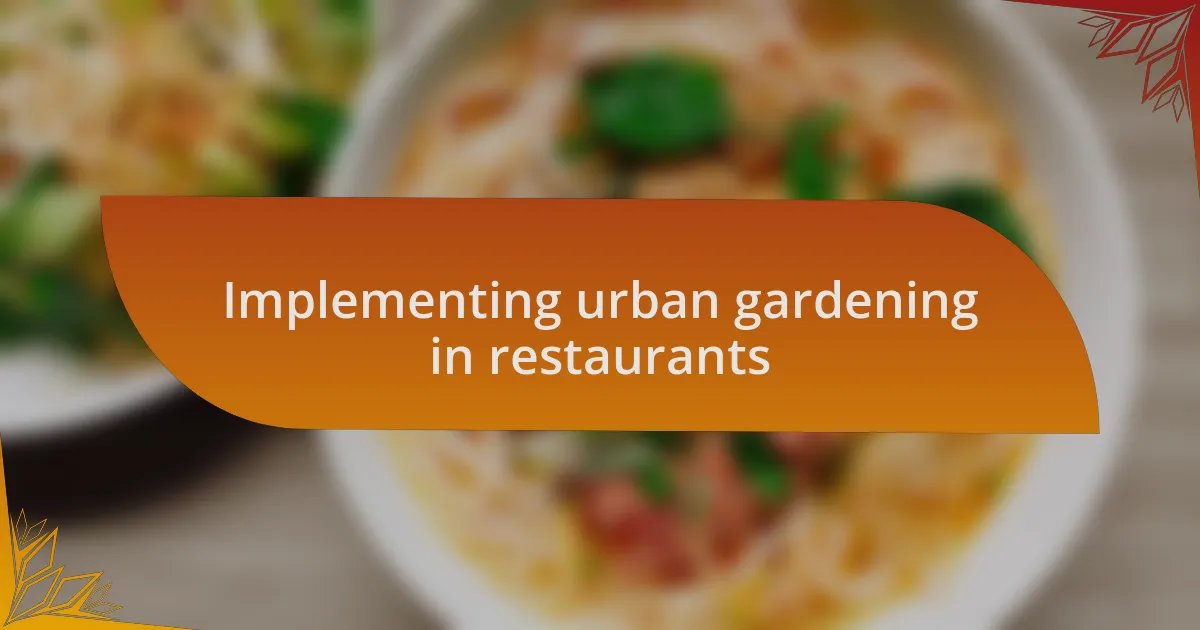
Implementing urban gardening in restaurants
Implementing urban gardening in restaurants can transform the way we think about sourcing food. I remember when I helped a local café set up their rooftop garden; the excitement from the kitchen staff was infectious. They were thrilled to have fresh herbs and vegetables at their fingertips, which not only enhanced the flavor of their dishes but also created a direct connection between the garden and the table. Have you ever tasted a meal made with ingredients harvested just moments before?
One significant advantage of urban gardening is the ability to educate patrons about where their food comes from. During one of my recent visits to a restaurant that had transformed its patio into a mini-garden, I watched as diners engaged with the gardening staff. Questions flowed about growing techniques and the benefits of sourcing locally. This interaction not only enriched their dining experience but also fostered a community spirit around sustainability. How powerful is it to inspire conversations about food security and health right from the dining table?
Sustainability projects through urban gardens also encourage waste reduction, which I’ve seen firsthand in my own initiatives. At one establishment I collaborated with, composting kitchen scraps became a daily practice, feeding the garden and closing the loop on waste. Witnessing that cycle—food scrap to compost to thriving plants—was a profound reminder of how interconnected our systems are. In your experience, how often do we stop to consider the impact of each ingredient on our planet?
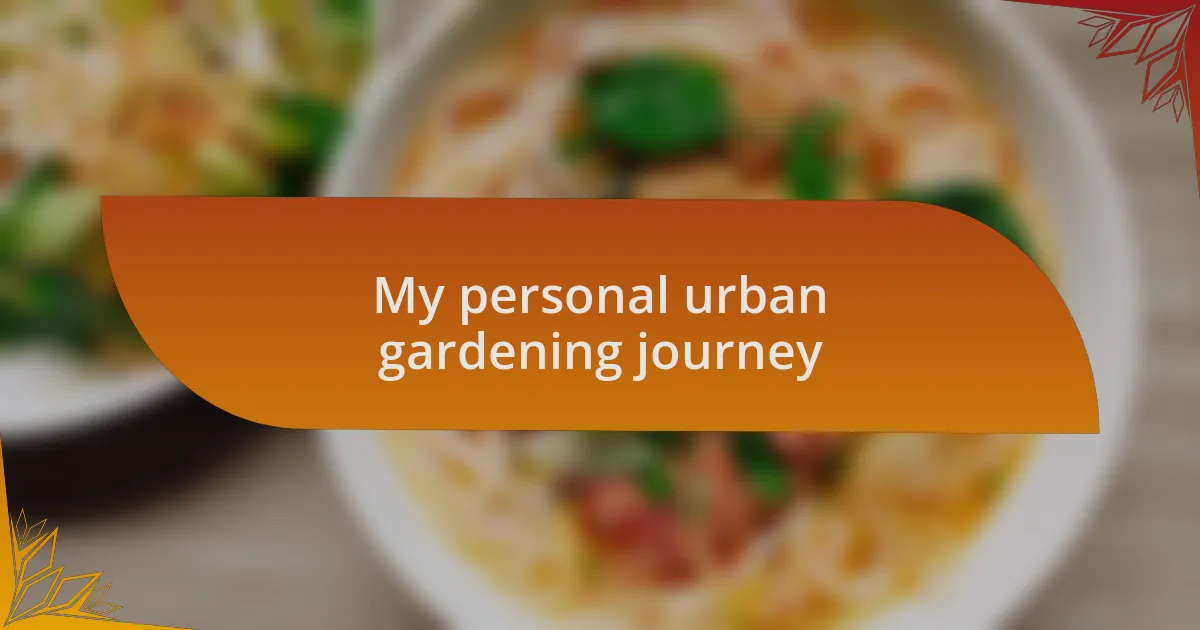
My personal urban gardening journey
My personal journey into urban gardening began quite unexpectedly. I still remember the first time I dropped seeds into that small patch of soil on my balcony. I was filled with anticipation, not just for the plants but for the experience itself, and as those seedlings broke through the earth, it felt like nurturing a little part of nature amidst the concrete jungle.
As I tended to my garden, I noticed something remarkable happening—not just in the plants, but in my own mindset. There was a sense of peace that came from the routine of watering, pruning, and harvesting. It became a meditative practice; I found myself reflecting on the nuances of life while enjoying the sun on my skin. Have you ever experienced that sense of calm, just from working with your hands in the soil?
Over time, my small urban garden transformed into a vibrant oasis, drawing in neighbors who were curious about my little green corner. Sharing fresh produce with them became a joy, and their reactions—faces lighting up at the taste of vine-ripened tomatoes or fragrant basil—made my efforts feel worthwhile. It’s incredible how a simple plant can spark connections and conversations, isn’t it? Each harvest reinforced my belief that urban gardening is not just about food; it’s about building community and nurturing our relationship with nature.
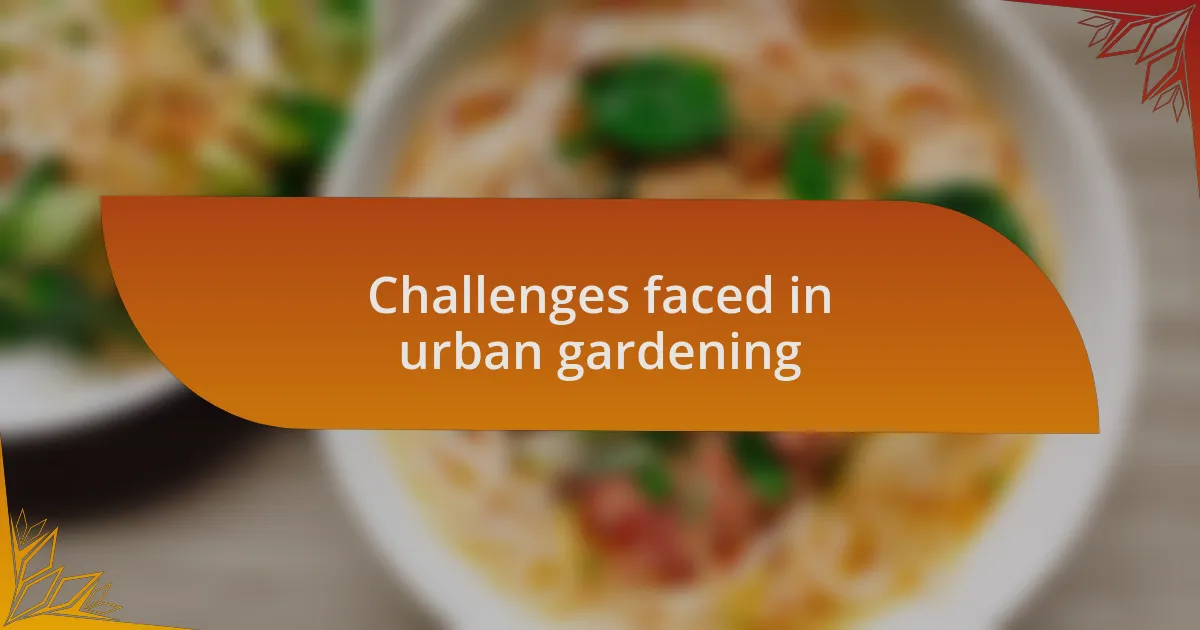
Challenges faced in urban gardening
Urban gardening presents its own unique set of challenges, which can sometimes feel overwhelming. For example, I vividly remember struggling with limited sunlight during certain months. My herbs seemed to acknowledge my efforts with stunted growth, making me wonder whether they were giving me a subtle hint to shift my gardening space or try artificial lighting. Have you ever experienced that frustration when nature doesn’t cooperate?
Another hurdle I faced was dealing with pests. One summer, I noticed aphids infiltrating my beloved tomato plants, and it felt like an invasion of my personal little paradise. I experimented with different organic solutions, learning that pest management is just as much a part of the process as sowing seeds. It’s a balancing act, isn’t it? Sometimes, I felt like I was in a game of strategy, trying to outsmart tiny invaders while also nurturing life.
Watering was another challenge that taught me valuable lessons. Initially, I was unsure how much moisture my plants really needed, often overwatering or letting them dry out. This trial and error made me realize that urban gardening demands attentiveness and adaptability. Each droplet of water was like a connection, a reminder that every plant has its own personality and preferences. Have you ever had to relearn something you thought you mastered?
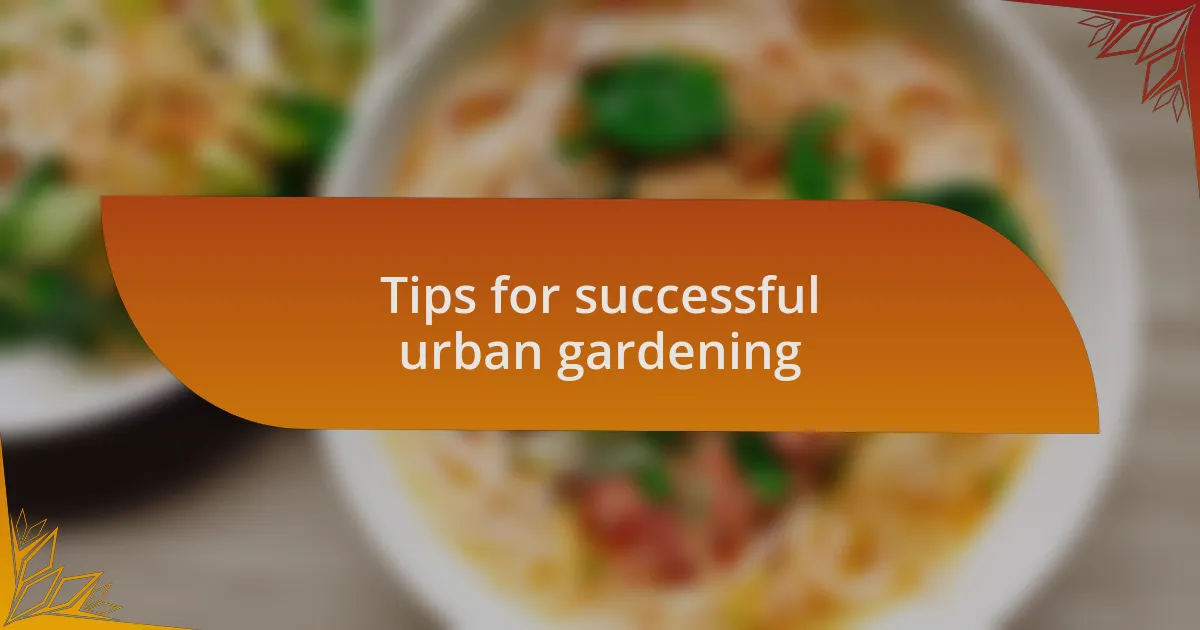
Tips for successful urban gardening
When starting your urban garden, I found that choosing the right containers can make a significant difference. I remember my first attempt, trying to use an old bucket for my herbs. It turned out to be way too small, and the roots desperately needed more space. Investing in larger pots with good drainage changed everything; it was like giving my plants a proper home. Have you thought about the kind of space your plants need to thrive?
One key aspect of success in urban gardening is understanding your microclimate. I’ve discovered that small factors—like the proximity to buildings or the orientation of your balcony—can influence what thrives and what doesn’t. For instance, my cherry tomatoes flourished in a sunny corner, but the basil nearby seemed to sulk in the shade. Observing these subtle changes in growth taught me to experiment with the layout of my garden, creating a happier ecosystem. What about your gardening space? Have you noticed areas with more sun or wind?
Lastly, I’d recommend engaging with your local gardening community, either online or in person. Sharing experiences and learning from others has transformed my approach. One afternoon, I met a neighbor who introduced me to companion planting and how certain plants can actually enhance each other’s growth. That simple conversation opened up an entirely new perspective for me. What resources or communities have you tapped into as you journey through your urban gardening endeavors?